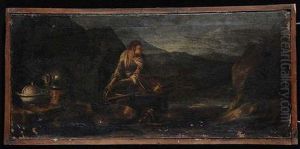Giorgio Bonola Paintings
Giorgio Bonola was an Italian architect and painter of the late Baroque period, primarily active in Milan. Born in 1663, his artistic journey began under the guidance of his uncle, Carlo Buzzi, who was also an architect. Bonola's style reflects the transition from the high Baroque to an early Rococo manner, which was becoming popular during the late 17th and early 18th centuries.
Although not as widely recognized as some of his contemporaries, Bonola made significant contributions to the architectural landscape of the Lombardy region. His works are characterized by a sense of movement and a delicate use of decorative elements, which were typical of the Rococo style that was emerging during his lifetime.
Bonola's most notable project was the design of the Sanctuary of the Blessed Virgin of the Miracles in Saronno, which he worked on from 1698 until his untimely death in 1700, at the age of 37. The sanctuary is renowned for its elegant cupola and intricate stucco work, which exemplify his mastery of Baroque architectural elements.
Despite his relatively short life, Giorgio Bonola left behind a legacy that influenced the architectural direction of sacral buildings in Northern Italy. His work remains a testament to the skill and creativity of late Baroque architects and their ability to adapt and evolve their style in response to changing artistic trends.
